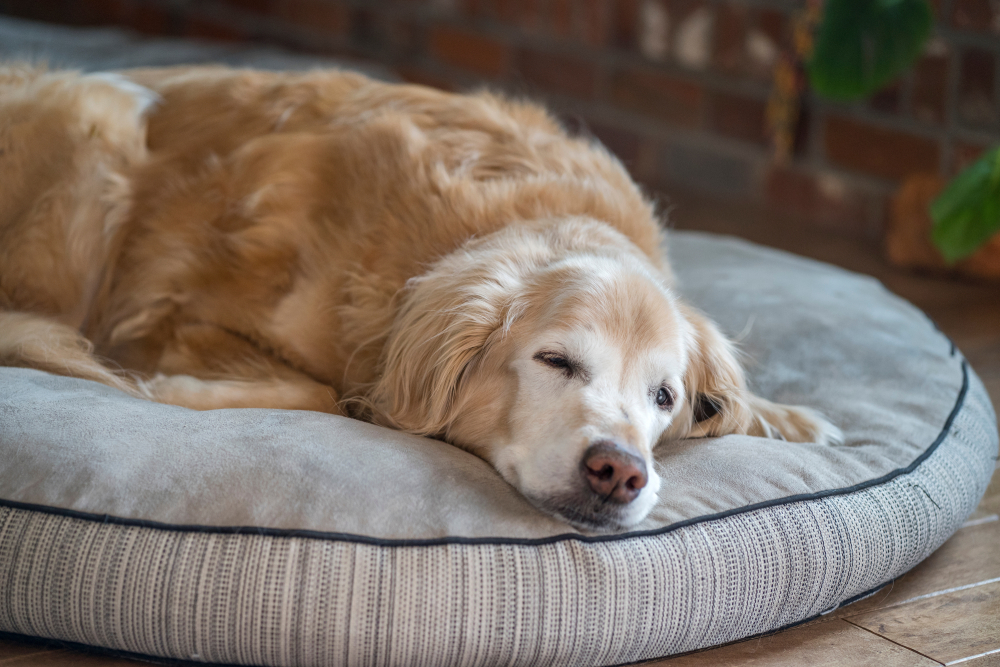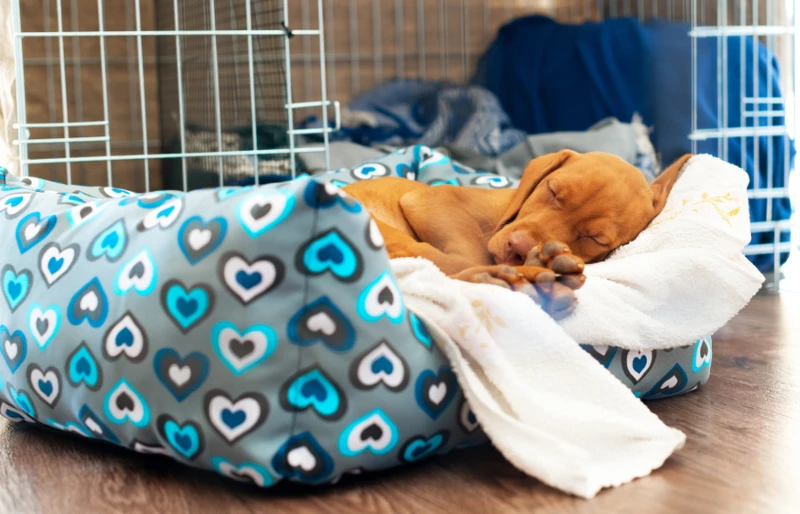In this article
Sleeping with the dog is a delightful idea that doesn’t always work as well as we hope. While the cuddles and warmth are welcome, the drawbacks are easy to regret before long. Dogs can muscle between spouses, pin blankets like boulders, and shed hair all over the sheets. Plus, they can disturb our rest with their constant stirring and awkward sleeping positions.
Although you might be ready to stop your dog from coming into your bed, they likely love the current arrangement. To be fair, it’s all your fault for letting them in the bed in the first place. They won’t be happy about a new routine, meaning you need a gentle, considerate approach to changing their sleeping place. You can ditch co-sleeping and get a good night’s rest with these tips to get your dog to stop sleeping in your bed.

How to Get Your Dog to Stop Sleeping in Your Bed
Abruptly “kicking” your dog out of your bed can be a harsh blow to your pet’s bond with you, as they will not understand why they suddenly are not allowed in. They consider your bed theirs, so it would be unfair and confusing for them, leaving them wondering why you’re punishing them. As much as it might help your sleep, being abrupt and careless will pull on your conscience as much as it will hurt your dog’s feelings and trust.
Like training anything else, developing your dog’s comfort with sleeping in their own bed centers on making it more rewarding than sleeping with you. It can take a while to settle into the routine, especially if your dog has slept with you for a long time.
You’ll preserve your dog’s trust and your relationship by using positive reinforcement and predictability to convince them to sleep in their space.
1. Get a Comfortable Dog Bed
You can’t expect an easy time keeping your dog off the bed if your mattress is a thousand times more comfortable than theirs. A cozy, secure sleeping spot is one of the essential incentives you have to supply to entice them into their own space. Besides, our dogs deserve the best.
Monitor how your dog sleeps so you can get a bed that fits them. Maybe they curl up in a donut, or they might be a side sleeper that extends their legs. Once you know the size and shape of their sleeping area, you can find a bed to match, ideally a soft and supportive one. You may even consider a small mattress to make it as enjoyable as possible.
Nest beds are a comforting bed style for dogs that like to snuggle. Alternatively, you can put plush blankets on their bed to enhance the feeling of coziness and security. Add in your dog’s favorite toys for further encouragement, providing extra-special “nighttime-only” toys for when they get into their bed.

2. Teach Your Dog to “Go to Bed”
A “place” or “bed” command is a handy way to acclimate your dog to going to their designated spot. At the same time, it gives you more opportunities to develop positive associations with their bed, encouraging a preference for it.
You can work a command into your daily training sessions and repeat it multiple times throughout the day. Rewarding your dog for getting all four paws on their bed will build that connection between the cue and the action.
Using positive reinforcement with praise, food, and toys will get them to associate their bed with a happy experience. They will eventually choose to go there themselves, but it may take weeks of patience and repetition. Keep them on the bed using the command “stay,” provide rewards, and extend the time they must stay in their place gradually. It may be as long as a minute to start with.
3. Gently Correct Behaviors
You should never punish your dog when they get on your bed. Old habits die hard, so you can’t blame them for trying to sneak in when they can. By making their bed more rewarding than yours, they’ll eventually choose the option with the most benefit.
When your dog jumps on your bed, tell them “No” in a firm but not angry voice, and lead them off by lifting them, nudging them, or guiding them by the collar. You don’t have to reward them for getting off or make a fuss over their misstep. You only have to communicate through your actions, “I do not want this, and being in this bed will not be rewarding.” As soon as they are back in their bed, give them a treat or praise their good decision-making.

4. Reinforce Your Dog Choosing Their Bed
Capturing moments when your dog uses their bed is an ongoing reinforcement strategy to show how rewarding it can be. If you notice your dog goes to their bed without being told at random points during the day, give them a treat and praise.
Letting them think and decide for themselves will solidify those positive connections to their bed.
5. Create a Consistent Routine
The habit of getting your dog to sleep in their bed is what you want to reinforce, and lying in your bed is the habit you want to go extinct. According to the matching law, animals with two options will pick the one that consistently gives them the most high-value reward. Their behavior occurs according to the amount of reinforcement behind both choices.
Consistency is crucial in applying more reinforcement to the dog bed than your bed. You must avoid rewarding your dog when they get into your bed. Don’t give them any affection, words of praise, or chances to get comfy. Just say “no” and get them off the bed.
Most critical of all, everyone in the house must know and stick to the rules. It does no good if you are 100% consistent while your spouse lets them snuggle, reinforcing that old behavior. You can’t allow any leniency or excuses for letting the dog into the bed like, “Oh, just this one time,” or, “They’ve been so good.” There must be complete consistency from everyone.


Tips to Get Your Dog to Stop Sleeping in the Bed
It can take a while for your dog to get used to sleeping on their bed. The longer they’ve been sleeping with you, the harder it will be to break the habit. The previous steps will get you on the road to success, and the following tips can help you take a few shortcuts on the way.
1. Keep Your Bedroom Door Closed
Promoting the right behaviors goes hand-in-hand with reducing the wrong ones. As you praise and reward your dog for choosing their bed, stop them from reinforcing their old routine by blocking access to your bed.
Keep the door closed day and night so they can’t sneak in, and they’ll break the habit more easily.
2. Walk Your Dog Before Bedtime
Tiring your dog out before bedtime with light exercise is a perfect precursor to a good night’s rest. A light walk or indoor puzzle games are excellent ideas. You must ensure your dog gets ample exercise and enrichment throughout the day, but an extra push just before bed will help them get to their sleeping spot with minimal fuss.

3. Crate Train Your Dog
Crate training is a great option for many dogs and should be started early on in a puppy’s life. The crate should be their safe and cozy place, where they can rest on a nice soft bed, play with toys, and get treats, and they will seek it when they feel overwhelmed or when it’s bedtime. With adequate training, you will not need to close the crate door overnight; your dog will prefer to sleep there themselves.
One of the many benefits of crate training your dog is building a habit of sleeping alone. Even if your dog is older, you can still use a crate to help them stay off the bed, avoid separation anxiety, and reduce problem behaviors, but only if they are used to being in a crate and feel safe there.
By giving them an enclosure with comfortable bedding and crate-only treats and toys, you can help them develop a preference for their personal resting spot.

Final Thoughts
Changing the nighttime routine can feel like we’re letting our dogs down or showing we don’t care about them. When getting dogs to stop sleeping in our beds, we must change our perspective as much as our pets’.
By staying positive and training your dog to go to their sleeping space, you aren’t taking anything from them. You’re offering an opportunity by giving them an alternative that can be just as rewarding as sleeping in your bed, if not more!
Featured Image Credit: Daniel Besic, Shutterstock




















